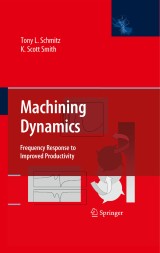Details

Machining Dynamics
Frequency Response to Improved Productivity|
139,09 € |
|
| Verlag: | Springer |
| Format: | |
| Veröffentl.: | 27.11.2008 |
| ISBN/EAN: | 9780387096452 |
| Sprache: | englisch |
| Anzahl Seiten: | 310 |
Dieses eBook enthält ein Wasserzeichen.
Beschreibungen
<P>"Machining dynamics: Frequency response to improved productivity" will train engineers and students in the practical application of machining dynamics, with a particular focus on milling. The book is arranged such that the steps required to improve machining productivity through chatter avoidance and reduced surface location error (forced vibrations resulting in part geometric errors) are clearly evident.</P>
<P></P>
<P>The following topics are covered in detail: modal analysis, including experimental methods, to obtain the tool point frequency response function; descriptions of turning and milling, including force modeling, time domain simulation, stability lobe diagram algorithms, and surface location error calculation for milling; and receptance coupling methods for tool point frequency response prediction, including beam theory. Numerical examples are included, as well as the MATLAB code used to develop the figures.</P>
<P> </P>
<P></P>
<P>The following topics are covered in detail: modal analysis, including experimental methods, to obtain the tool point frequency response function; descriptions of turning and milling, including force modeling, time domain simulation, stability lobe diagram algorithms, and surface location error calculation for milling; and receptance coupling methods for tool point frequency response prediction, including beam theory. Numerical examples are included, as well as the MATLAB code used to develop the figures.</P>
<P> </P>
<P>"Machining dynamics: Frequency response to improved productivity" will train engineers and students in the practical application of machining dynamics, with a particular focus on milling. The book is arranged such that the steps required to improve machining productivity through chatter avoidance and reduced surface location error (forced vibrations resulting in part geometric errors) are clearly evident.</P>
<P></P>
<P>The following topics are covered in detail: modal analysis, including experimental methods, to obtain the tool point frequency response function; descriptions of turning and milling, including force modeling, time domain simulation, stability lobe diagram algorithms, and surface location error calculation for milling; and receptance coupling methods for tool point frequency response prediction, including beam theory. Numerical examples are included, as well as the MATLAB code used to develop the figures.</P>
<P> </P>
<P></P>
<P>The following topics are covered in detail: modal analysis, including experimental methods, to obtain the tool point frequency response function; descriptions of turning and milling, including force modeling, time domain simulation, stability lobe diagram algorithms, and surface location error calculation for milling; and receptance coupling methods for tool point frequency response prediction, including beam theory. Numerical examples are included, as well as the MATLAB code used to develop the figures.</P>
<P> </P>
Modal Analysis.- Turning Dynamics.- Milling Dynamics.- Surface Location Error in Milling.- Special Topics in Milling.- Tool Point Dynamics Prediction.
<P><EM>Machining Dynamics: From frequency response to improved productivity </EM>will train engineers and students in the practical application of machining dynamics, with a particular focus on milling. The book is arranged such that the steps required to improve machining productivity through chatter avoidance and reduced surface location error (forced vibrations resulting in part geometric errors) are clearly evident. The following topics are covered in detail: modal analysis, including experimental methods, to obtain the tool point frequency response function; descriptions of turning and milling, including force modeling, time domain simulation, stability lobe diagram algorithms, and surface location error calculation for milling; and receptance coupling methods for tool point frequency response prediction, including beam theory.</P>
<P>Readers will find: <BR>clear descriptions of predictive algorithms for machining process performance<BR>comprehensive coverage of the fundamentals of machining dynamics <BR>numerous numerical examples<BR>functional MATLAB® code for process predictions.</P><EM>
<P>Machining dynamics: From frequency response to improved productivity </EM>will serve as a valuable resource for practicing manufacturing engineers and graduate students interested in learning how to improve machining productivity through consideration of the process dynamics.</P>
<P>Readers will find: <BR>clear descriptions of predictive algorithms for machining process performance<BR>comprehensive coverage of the fundamentals of machining dynamics <BR>numerous numerical examples<BR>functional MATLAB® code for process predictions.</P><EM>
<P>Machining dynamics: From frequency response to improved productivity </EM>will serve as a valuable resource for practicing manufacturing engineers and graduate students interested in learning how to improve machining productivity through consideration of the process dynamics.</P>
<p>Provides a clear description of predictive algorithms for process performance</p><p>Provides the necessary information in a manner that enables rapid implementation</p><p>Offers a comprehensive source of the fundamentals of machining dynamics that leads to reduced reliance on handbooks and rules of thumb</p><p>Includes functional MATLAB code for process predictions</p>
Diese Produkte könnten Sie auch interessieren:

Kunst und Werk

von: Alexander Friedrich, Petra Gehring, Christoph Hubig, Andreas Kaminski, Alfred Nordmann

39,90 €

English for Science and Technology (C1)

von: Ines K. Böhner, Gretchen Chojnacki-Herbers, Joseph Michaels, John D. Nixon

29,99 €

Technology and Business Model Innovation: Challenges and Opportunities

von: Bahaaeddin Alareeni, Allam Hamdan

213,99 €













